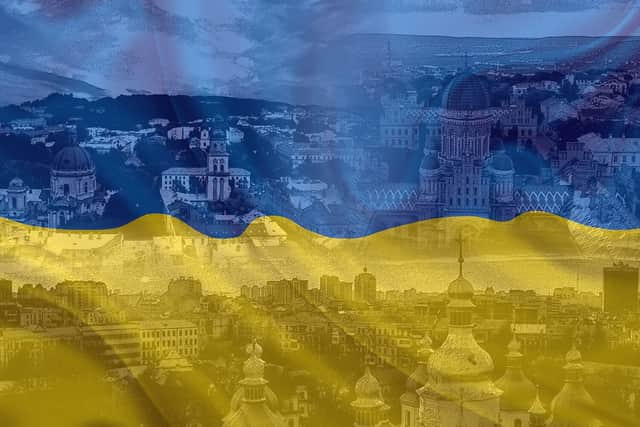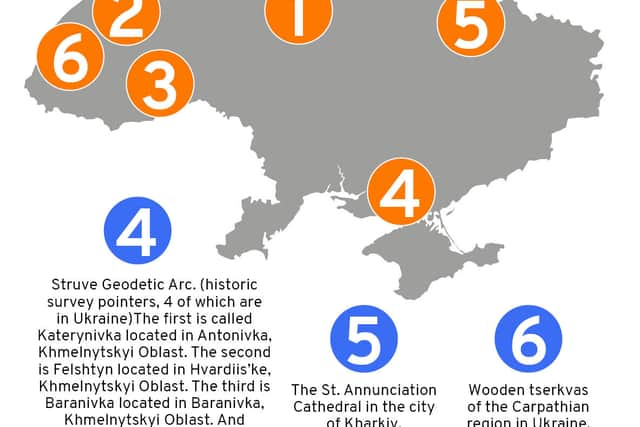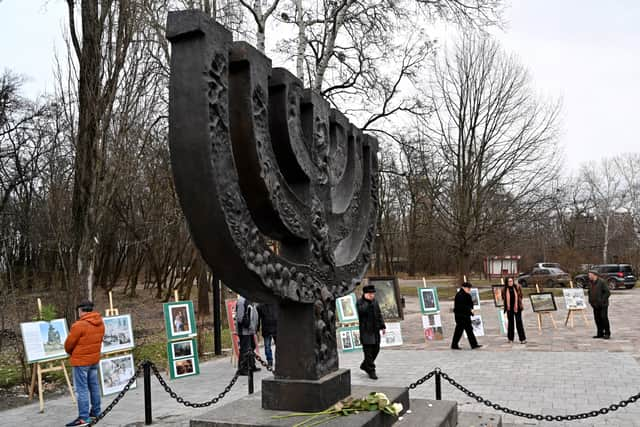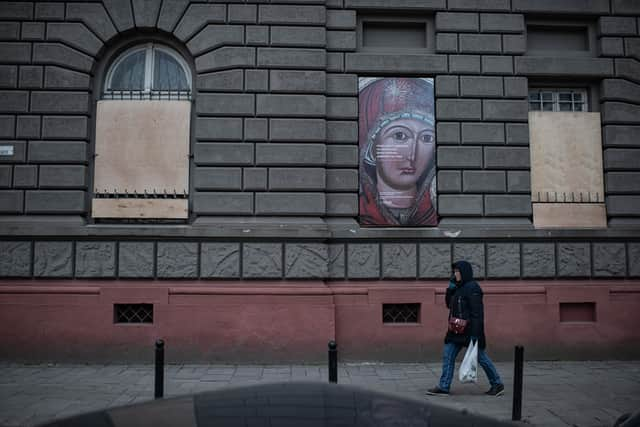Why is Ukraine’s culture at threat? What has been damaged and is cultural destruction a war crime
and live on Freeview channel 276
Ukraine is facing an ongoing battle to protect its people as the Russian invasion continues, but the country is also struggling to save its most significant historical and cultural sites.
One of Ukraine’s important sites, the Assumption Cathedral in Kharkiv, the second-largest city, has been damaged in recent attacks - and experts say the potential for accidental damage of these sites is high.
Advertisement
Hide AdAdvertisement
Hide AdThe United Nations Educational, Scientific and Cultural Organisation (UNESCO) continues to receive “more and more reports of the destruction of cultural heritage in several cities”.
The UN’s cultural body has also repeatedly called for the protection of significant landmarks in the country.
What are Ukraine’s important cultural sites?


Ukraine is home to seven World Heritage sites, including the 1,000-year-old St Sophia’s Cathedral in the heart of the capital Kyiv.
Here are the country’s most important cultural sites.
St Sophia’s Cathedral complex, Kyiv
St. Sophia is a Christian cathedral in the centre of Kyiv.
It was a model for later churches in the region and is one of the most important Christian shrines in Western Europe.
Advertisement
Hide AdAdvertisement
Hide AdUNESCO has listed two components - the Saint-Sophia Cathedral and its related monastic buildings and the monastic complex of Kyiv-Pechersk Lavra, known as the Monastery of the Caves.
The Monastery of the Caves includes underground monastic cells, tombs of saints and above-ground churches.
It was built across nearly nine centuries and is a masterpiece of Ukrainian art.
Lviv’s historic centre
UNESCO has granted World Heritage status to Lviv’s historic centre.
Advertisement
Hide AdAdvertisement
Hide Ad"The mediaeval urban topography has been preserved virtually intact, along with many fine Baroque and later buildings," UNESCO says.
The National Museum houses the country’s most complete collection of sacred mediaeval art and rare religious manuscripts.
Residence of Bukovinian and Dalmatian Metropolitans, Chernivtsi
In 2011 this site was inscribed in UNESCO’s World Heritage List.
Advertisement
Hide AdAdvertisement
Hide AdThe complex consists of three buildings, a square, a church, and a garden is the landmark of Chernivtsi city.
It is called “Ukrainian Hogwarts” as a university is located in the walls of the former residence now.


Struve Geodetic Arc
The Struve Geodetic Arc are historic survey pointers that stretch more than 2,800 kilometres across ten countries, including Ukraine.
It was made a World Heritage Site in 2005.
UNESCO says German astronomer Friedrich Georg Wilhelm von Struve used the markers for the first accurate measuring of a meridian, which "helped to establish the exact size and shape of the planet and marked an important step in the development of earth sciences and topographic mapping".
Advertisement
Hide AdAdvertisement
Hide AdThe northernmost point is located near Hammerfest in Norway and the southernmost point near the Black Sea in Ukraine.
Of the 34 listed nodes, four lie in Ukraine.
The Annunciation Cathedral, Kharkiv
The St. Annunciation Cathedral in the city of Kharkiv is the largest cathedral in Eastern Europe and the city’s oldest orthodox church.
The first church was founded around 1655 but the current structure was completed in the late 19th century.
Wooden tserkvas of the Carpathian region in Ukraine
Situated across the border region of Ukraine and Poland, these 16 wooden churches were built by Orthodox and Greek Catholic communities - eight are located in Ukraine and eight in Poland.
Advertisement
Hide AdAdvertisement
Hide AdThey are located in isolated parts of the Carpathian Mountain and were built in the 16th-19th centuries.
Ancient city of Tauric Chersonese and its chora
Situated in the city of Sevastapol in Crimea, the site features remains of a city founded in the fifth century BC on the northern shores of the Black Sea.
It includes public buildings, residences and "well-preserved examples of vineyard planting and dividing walls", according to UNESCO.
What has been damaged so far?
The Ivankiv Historical and Local History Museum, northwest of the capital city Kyiv, which housed dozens of works by the Ukrainian folk artist Maria Prymachenko has been bombed and damaged, with some cultural assets now lost forever.
Advertisement
Hide AdAdvertisement
Hide AdLazare Eloundou, head of UNESCO’s World Heritage Centre, said the UN’s cultural body was receiving “more and more reports of the destruction of cultural heritage in several cities.
“The whole of cultural life has been affected, and we have grave concerns about what will happen next.”
Russian forces have also shelled the Assumption Cathedral on 2 March.
Lviv museum director Olha Honchar told the Guardian what Moscow’s aims are in Ukraine, she said: “Moscow wants to eradicate Ukrainian culture. It’s what defines us and our identity.
“It’s a memory of who we are.”
Advertisement
Hide AdAdvertisement
Hide AdA Holocaust memorial park in Kyiv was also damaged by a missile attack.
Babyn Yar, also known as Babi Yar, was the site of one of the largest mass killings where Jewish people were lined up and shot.


A museum building which was not yet in use caught fire, and there was damage across the 140-acre site, the BBC was told.
The attack followed Mr Putin’s statement calling Ukraine’s leaders “neo-Nazis” and said his goal was the “denazification” of the country.
Advertisement
Hide AdAdvertisement
Hide AdThe chair of Babyn Yar’s advisory board, Natan Sharansky, said the Russian leader had sought "to distort and manipulate the Holocaust to justify an illegal invasion of a sovereign democratic country" in the "utterly abhorrent" move.
How are local people protecting Ukraine’s cultural heritage?
Curators believe the collections they protect in the Lviv National Museum within the city’s historic centre will become targets in the war, and so they have secured them by dividing and housing them in secret locations.
There are back-up plans to move them further afield if the museum feels like they are vulnerable.


The museum’s cultural secretary, Angelina Zabytivska, said: "We have to preserve our culture, we have to preserve the pieces that were left for us by our fathers, grandfathers, by previous generations because we have to be, we have to exist and in this collection, we present our national memory – it is our national soul baked into every item”.
Advertisement
Hide AdAdvertisement
Hide AdSeveral of the city’s treasures were hidden including a precious wooden alter-piece showing Jesus, Mary and Mary Magdalene.
City council workers in Lviv also rescued four limestone fountains adorned with mythical sculptures that occupy a corner of the old market square.
More than 1,000 librarians, archivists and researchers are involved in Saving Ukrainian Cultural Heritage Online.
Meanwhile, UNESCO has said that it is marking cultural sites and monuments in Ukraine with the distinctive “Blue Shield” emblem of the 1954 Hague Convention for the Protection of Cultural Property in the Event of Armed Conflict.
Advertisement
Hide AdAdvertisement
Hide AdWhy is Ukraine’s cultural heritage at threat?
Ukraine and Russia have close cultural and religious ties, but since Russia first invaded Ukraine in 2014, a divide has developed between the Orthodox Churches of both countries.
In 2019, the Orthodox Church of Ukraine was granted independence by the Ecumenical Patriarch in Istanbul, marking a historic split from Russia - one which outraged Russian political and religious leaders.
Ukrainian leaders still view the split as vital to the country’s security.
Ukraine’s churches have for centuries been under the authority of the leaders of the Russian Orthodox Church in Moscow, but the decree pressured Ukrainian clerics to choose between the Russian-supported Ukrainian churches and the new church.
Advertisement
Hide AdAdvertisement
Hide AdRussia and Ukraine have particular religious and cultural tensions as a result of these events, causing concern for these sites across the country.
Is it a war crime to destroy cultural heritage?
The deliberate destruction of a country’s or culture’s heritage is a war crime.
UNESCO says the targeting of cultural sites has evolved into a tactic of war to damage and attempt to destroy societies over a prolonged period.
Speaking on the importance of protecting Ukraine’s cultural heritage, Mr Eloundou said: “Today, museums are damaged, some with collections inside.”
He added: “There are also cultural venues that are damaged.
“It is a whole cultural life that risks disappearing.”
Comment Guidelines
National World encourages reader discussion on our stories. User feedback, insights and back-and-forth exchanges add a rich layer of context to reporting. Please review our Community Guidelines before commenting.
